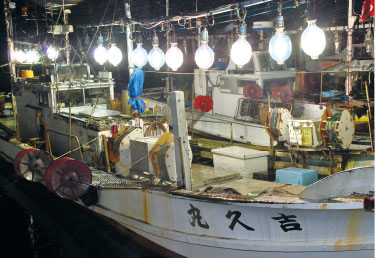You will also find models and dioramas of fishing vessels, as well as fishing implements, on display. Learn all about creatures like crabs and squid.
![]()
Specimens from the fisheries industry and informational panels tell you about signature trades from Kasumi, such as crab and squid fishing.

![]()
Three-dimensional displays recreate the open sea and describe how fish are caught.



Sokonikiami-gyogyo
Dates: September through end of May of the following year
Sea bottom trawl boats ranging from 19-125 tons are in operation in Kami-cho.
Fishing involves sinking nets from 100-800m below the surface and spanning from offshore of Kyoto Prefecture to offshore of Yamaguchi Prefecture and trawling the sea bottom.

Benizuwaigani-kago-gyogyo
Dates: September through end of June of the following year
(June is voluntarily closed for fishing in order to conserve resources)
Small ships weighing 19 tons operate baskets and can run for one day, and larger ships up to 80 tons operate baskets and can run for 4-5 days. They sink their baskets 800-1,500m below the surface to put lures for mackerel and Beni-zuwaigani.

Ikatsuri-gyogyo
– Dates of operation: year-round
Using small fishing boats of 20 tons or lighter, lights are turned on to draw common squid closer and catch them in automated nets. These nets are operated from Kyoto to offshore Tottori, with permission obtained from other prefectures for fishing common squid in some parts throughout the year along the Sea of Japan. Illuminated night fishing is a unique form of fishing in which boats along the coast are lit up with lights used to draw the prey closer.

Teichiami-gyogyo

– Dates of operation: year-round
Nets are placed in the open sea and used to catch amberjack, mackerel, horse mackerel, and other fish. By making use of the fact that the fish try to flee when caught in the nets, an encircled shape is used to catch them on the return and lead them into other nets. Large, fixed-point nets are installed at points 27m and deeper, and smaller nets are installed along the coastline.
●Source: 2012 Tajima Fisheries Industry/2008 Tajima Fisheries Industry; Tajima Fisheries Cooperative web site









